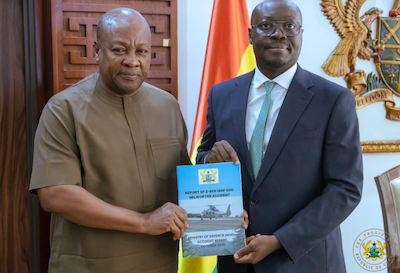In a somber revelation that has gripped the nation, the official probe into the August 6, 2025, military helicopter disaster in Ghana’s Ashanti Region has unveiled 10 critical insights into the tragedy that claimed the lives of eight prominent figures.
The Z-9 aircraft, en route from Accra to a mining initiative event in Obuasi, plummeted into the rugged Dampa Range Forest Reserve amid a routine government mission. Among the victims were Defence Minister Dr. Edward Omane Boamah and Environment Minister Dr. Ibrahim Murtala Mohammed, alongside senior officials like NDC Vice-Chairman Dr. Samuel Sarpong and Acting Deputy National Security Coordinator Alhaji Muniru Mohammed Limuna. This long-overdue report, presented by retired pilot Captain Paul Forjoe at Jubilee House on November 11, 2025, draws from flight data, voice recordings, and expert analysis to expose layers of vulnerability in the skies.
Ghana’s Deadly Helicopter Crash Inquiry: 10 Shocking Findings
The first revelation underscores the helicopter’s mechanical soundness, confirming the 12-year-old Chinese-built Z-9 was fully airworthy with no pre-existing faults in engines or structure. Yet, the second finding paints a dire picture of the flight’s prelude: severe weather patterns, including sudden downdrafts and low visibility from monsoon-like rains, forced a one-hour takeoff delay from Accra’s airfield. Investigators noted the third key issue pilots Squadron Leader Peter Bafemi Anala and Flying Officer Manin Twum-Ampadu pressed on despite these warnings, a decision the fourth insight attributes to mounting pressure from the high-profile passengers eager to attend the Responsible Cooperative Mining and Skills Development Programme launch.
Delving deeper, the fifth revelation highlights a glaring equipment shortfall: the absence of a Terrain Awareness and Warning System (TAWS), which could have alerted the crew to the impending collision with the hilly terrain. The sixth finding exposes navigational gaps, as the aircraft’s outdated radar failed to integrate real-time meteorological updates, leaving the team blind to escalating wind shears. Crew member Sergeant Ernest Addo Mensah’s final transmissions, detailed in the seventh insight from the cockpit voice recorder, reveal frantic efforts to regain lift amid the chaos, but the downdraft’s ferocity proved insurmountable, causing a rapid 500-foot altitude loss in mere seconds.
The probe’s eighth bombshell targets systemic flaws in Ghana’s aviation oversight, pointing to insufficient recurrent training for pilots handling VIP transports in volatile weather. Ninth, it unmasks inadequate maintenance protocols for the aging fleet, where routine checks overlooked potential vulnerabilities in rotor blades exposed to tropical humidity. Finally, the tenth revelation calls for sweeping reforms, urging the immediate procurement of simulators and modern helicopters equipped with advanced avionics to avert future aerial calamities.
As Ghana mourns this irreplaceable loss, the inquiry’s blueprint offers a path forward, emphasizing accountability and investment in air safety. Families of the fallen, including those of disaster relief deputy Samuel Aboagye, have welcomed the transparency, though calls for a national welfare fund grow louder. This tragedy not only scars the political landscape but ignites urgent debates on balancing ambition with caution in the nation’s skies, ensuring such a “Black Wednesday” fades into preventable history.
Background to the story: Helicopter Crash in Ghana That Claimed Eight Lives
A video went viral following the helicopter crash that captured a man believed by many to be a prophet warning the nation about an impending plane crash.He instructed the leaders of the country to heed to his warnings and seek spiritual guidance which was apparently ignored by ruling party leaders.
He again went viral after the news broke out with many opining that his warnings could have averted the unfortunate incident. Ghanaians have expressed mixed views about his revelations leading to government institutionalization of an authority to review prophecies by these self-acclaimed prophets which yielded no tangible results.



